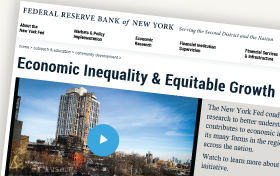Just Released: Household Debt Balances Increase as Deleveraging Period Concludes
Andrew F. Haughwout, Donghoon Lee, Joelle Scally, and Wilbert van der Klaauw The New York Fed released the Quarterly Report on Household Debt and Credit for the third quarter of 2014 today. Balances continued to rise slightly, with an overall increase of $78 billion. The aggregate household debt balance now stands at $11.71 trillion, up […]
Bitcoin: How Likely Is a 51 Percent Attack?
Rod Garratt and Rosa Hayes In June 2014, the mining pool Ghash.IO briefly controlled more than half of all mining power in the Bitcoin network, awakening fears that it might attempt to manipulate the blockchain, the public record of all Bitcoin transactions. Alarming headlines splattered the blogosphere. But should members of the Bitcoin community be […]
Historical Echoes: Postage Stamps Portray Stories of American Banking History
Prior to 1876, there was fierce competition among engraving firms and private bank note companies for contracts to print U.S. Treasury bank notes.
Introducing the SCE Credit Access Survey
Today, we are releasing new data on consumers’ experiences and expectations regarding credit demand.
The Long‑Term Unemployed and the Wages of New Hires
This is the third in a series of blog posts on the topic of measuring labor market slack. In this post, we assess the relationships between short- and long-term unemployment and wages by comparing the differences in states’ experiences over the business cycle.
How Attached to the Labor Market Are the Long‑Term Unemployed?
In this second post in our series, we analyze the labor market outcomes of long-term unemployed workers to assess their employability and labor force attachment.
Measuring Labor Market Slack: Are the Long‑Term Unemployed Different?
There has been some debate in the Liberty Street Economics blog and in other outlets, such as Krueger, Cramer, and Cho (2014) and Gordon (2013), about whether the short-term unemployment rate is a better measure of slack than the overall unemployment rate.
Historical Echoes: Personal Effects
Does the Federal Reserve or the government care about pocketbooks?
Did Local Funding Responses to Post‑Recession State Aid Cuts Vary by Property Wealth?
In the first of this two post series, we investigated the relationship between state aid and local funding before and after the Great Recession.
Did School Districts Offset State Education Funding Cuts?
It’s well known that the Great Recession led to a massive reduction in state government revenues, in spite of the federal government’s attempt to ease budget tightening through American Recovery and Reinvestment Act aid to states.














 RSS Feed
RSS Feed Follow Liberty Street Economics
Follow Liberty Street Economics